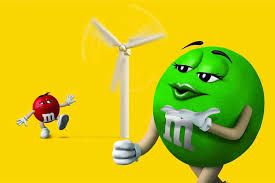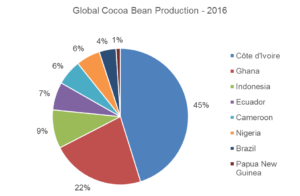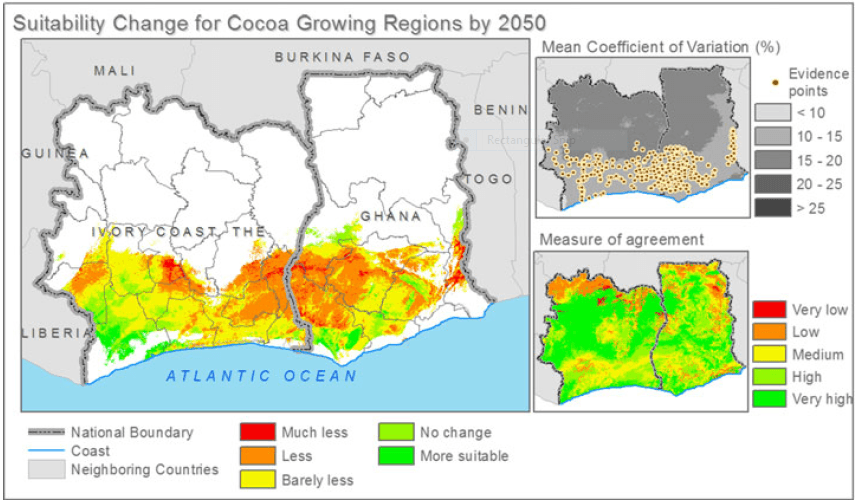Cuckoo for Cocoa: One Confectioner’s Push for Sustainability

As climate change threatens the future supply of cocoa, one company – Mars – looks to fortify its supply chain.
In 2016, chocolate lovers consumed roughly 7.3 million tons of chocolate worldwide. Global consumption has grown 2% annually since 2013 and is expected to continue to grow at 2% through 2019 [1]. While the world’s insatiable appetite for chocolate continues to grow, key areas of production might soon be at risk as a result of climate change. One key player in the industry, Mars, is taking major steps to build a sustainable supply chain for the future and to reduce the impact of its operations on climate change.
A Sticky Situation
Chocolate’s key ingredient, cocoa, is predominantly grown within 20 degrees north and south of the equator. Cocoa production is largely concentrated in a few West African countries (see figure 1), namely Cote d’Ivoire and Ghana, which together account for nearly 70% of global cocoa production [2]. For Mars – maker of favorite candy confections such as Milky Way, Mars, M&M’s, Snickers, and Twix – this dynamic presents a challenge to the Company’s supply chain in the face of climate change.

Cultivatable land in Cote d’Ivoire and Ghana is likely to decline, as these countries are expected to experience a temperature increase of 3.8 degrees Fahrenheit by 2050 [3]. This increase will result in higher levels of evaporation and plant transpiration to the atmosphere without a commensurate increase in rainfall. Consequently, land suitable for growing cocoa will be constricted over time, as illustrated in Figures 2 and 3 [4].


Given these challenges, Mars has outlined and begun to implement meaningful changes to secure the lifeblood of its delicious treats for years to come.
Chipping Away at a Chocolate Problem
In September 2017, Mars CEO Grant Reid emphasized the importance of addressing the sustainability of Mars’ global supply chain, saying, “The engine of global business – its supply chain – is broken, and requires transformational, cross-industry collaboration to fix it. [5]” Mars has made meaningful commitments in the short, medium, and long term to reduce its operations’ impact on climate change. The Company has pledged $1 billion over the next three years to its “Sustainable in a Generation Plan” aimed at, among other things, reducing its greenhouse gas (GHG) emissions and helping its cocoa producers prepare for the realities of climate change.
Wind energy is a key component of Mars’ GHG reductions. In recent years, Mars opened wind farms in Texas and Scotland, which generate the equivalent of 100% of the energy required to power Mars’ U.S. and U.K. operations, respectively. Similar plans for wind production in Mexico are underway. Additionally, Mars expects to power 100% of its operations in the Czech Republic, France, Spain, and Poland with renewable energy by 2018. This is all part of Mars’ goal to reduce its GHG by 27% by 2025 from its 2015 levels and by 67% by 2050.
Mars is also focused on helping cocoa farmers deal with climate change. In July 2017, Mars launched “The Farmer Income Lab” to improve “breeding, farming methods and protection against pests and disease for cocoa. [6]” To this end, Mars’ goal is to obtain 100% of its cocoa from certified sources by 2020. Additionally, Mars has committed to investing $280 million in Cote d’Ivoire alongside the government through 2025 to advance farmers’ livelihoods [7]. By providing resources and expertise to its cocoa farmers, Mars is working to mitigate the impact of climate change on its supply chain.
More Work to Do
To secure its long term supply chain, the Company must accelerate its involvement with local cocoa farmers. Today, Mars does not typically purchase raw materials from small farms, and while it has launched its Farmer Income Lab, its peers have moved more quickly. For instance, The Hershey Company began its “Learn to Grow” farmer training program in 2012, which impacted over 30,000 farmers across over 450 cocoa communities in 2015 [8]. Similarly, Mondelez launched its “Cocoa Life” program in 2012, which reached over 75,000 farmers in nearly 800 communities in 2015 [9].
In addition to enhancing its outreach to farmers, Mars needs to work directly with local governments and regulators to enhance their relationships with the small farmer communities. Local governments in these areas can play a meaningful role in increasing the level of engagement with small farmers, thereby accelerating the pace of potential technological change and socio-economic improvement [10].
Food for Thought
To date, Mars has made good progress in securing its supply chain vis-à-vis climate change. However, questions remain regarding additional steps the Company can take. Namely, how can Mars reduce its overall energy footprint rather than merely offset it with alternate energy sources? How should Mars define success with respect to enhancing the sustainability of its small farmers and suppliers? And finally, how can Mars create a competitive advantage through its sustainability efforts?
(794 words)
Works Cited
[1] ICCO. n.d. Retail consumption of chocolate confectionery worldwide from 2012/13 to 2018/19 (in 1,000 metric tons). Statista. Accessed 10 November, 2017. Available from https://www-statista-com.ezp-prod1.hul.harvard.edu/statistics/238849/global-chocolate-consumption/.
[2] ICCO. “World Cocoa Production by Country from 2012/2013 to 2016/2017 (in 1,000 Metric Tons).” Statista – The Statistics Portal, Statista, www.statista.com/statistics/263855/cocoa-bean-production-worldwide-by-region/, Accessed 10 Nov 2017
[3] Scott, Michon. 2016. “Climate & Chocolate | NOAA Climate.Gov”. Climate.Gov. https://www.climate.gov/news-features/climate-and/climate-chocolate.
[4] Läderach, P., A. Martinez-Valle, G. Schroth, and N. Castro. 2013. “Predicting The Future Climatic Suitability For Cocoa Farming Of The World’S Leading Producer Countries, Ghana And Côte D’Ivoire”. Climatic Change 119 (3-4): 841-854. doi:10.1007/s10584-013-0774-8.
[5] 2017. “MARS CEO: INDUSTRY MUST FIX ‘BROKEN’ ENGINE OF GLOBAL BUSINESS TO TACKLE URGENT CLIMATE & SOCIAL THREATS”. http://www.mars.com/docs/default-source/Press-Releases/sig-press-release-final.pdf?sfvrsn=4.
[6] “Farmers Income Lab – Helping Smallholder Farmers – Mars, Incorporated”. 2017. Mars, Incorporated. http://www.mars.com/global/press-center/newsroom/smallholder-farms-research.
[7] “MARS LAUNCHES FARMER INCOME LAB TO TACKLE ISSUE OF SMALLHOLDER FARMER INCOME”. 2017. http://www.mars.com/docs/default-source/default-document-library/farmer-income-lab_press-release_0710201734e2a95e0e2967c1ba01ff19007138ba.pdf?sfvrsn=0.
[8] “Learn To Grow Cocoa”. 2017. Corporate. https://www.thehersheycompany.com/en_us/responsibility/good-business/creating-goodness/learn-to-grow.html.
[9] “Cocoa Life Progress Report”. 2017. Mondelez International. http://www.mondelezinternational.com/newsroom/our-stories/cocoa-progress.
[10] Abbey, Prince, Philip R. Tomlinson, and J. Robert Branston. 2016. “Perceptions Of Governance And Social Capital In Ghana’s Cocoa Industry”. Journal Of Rural Studies 44: 153-163. doi:10.1016/j.jrurstud.2016.01.015.



This was a very interesting take on the future of my favorite food. While I have read a great deal about unethical treatment of laborers in the cocoa industry, I was unaware of how climate change will impact cocoa production. In addition to the solutions you’ve posed, I’m curious about whether Mars is considering two other alternatives: (1) diversifying the locations where the cocoa is sourced away from the West African countries that are being impacted by climate change and (2) whether they are looking into using cocoa substitutes. With respect to (1) we’d need to learn more about other areas of the world where the land is hospitable to harvesting cocoa, and whether these areas will be less impacted by climate change. For (2), it seems like there are some alternatives to cocoa, such as palm oil (see link to the Reuters article below). However would Mars, a iconic American chocolate company, want to venture into substitutes? Perhaps yes if cocoa becomes far more expensive, or worse, altogether unavailable.
https://www.reuters.com/article/us-asia-cocoa-substitute/as-cocoa-price-soars-chocolate-makers-devour-substitutes-idUSKBN0H009X20140905
I find this very interesting in that Mars is not only looking to make its supply chain more sustainable and eco-friendly, but also that it is taking steps today to protect its supply chain against climate change and its possible detrimental impact. Global warming will without a doubt be an issue for a lot of companies; Mars is a great example of a clear cause and effect relationship of raising temperatures on a company’s supply-chain. I wonder if something else can be done in addition to empowering and educating farmers. I really like Shalei’s suggestion above of considering a cocoa substitute. Alternatively, could the company make its chocolate-production process more efficient so that they require less cocoa? Is there anything else that could be done to make the farmers more efficient? Obviously, these are work-arounds to the impact of climate change instead of solutions to the issue. It is great to see Mars trying to tackle this complicated monster of an issue from multiple angles!
Great post! One way for Mars to move towards reducing its overall energy footprint would be to systematically capture the environmental impact of each of its products to assess how they compare on this dimension. Armed with this data, Mars could optimize for the production and advertising of these better for the environment products. This is the approach that fellow food company Danone has taken. Danone partnered with software company SAP to roll out a carbon calculation and management system that allows the company to measure carbon emissions for Danone’s 35,000 skus. This data allows managers to make strategic decisions that are sustainable.
Choc Talk, I really enjoyed reading your article! I was positively impressed to learn Mars is focusing much of its effort at the beginning of the value chain, investing in cocoa farmers and implementing mitigating strategies from the start.
An additional step Mars could take is investing in an even prior step of the supply chain: forests. At the moment, cocoa is causing great damage worldwide. As demand for the product increases and supply struggles to keep up due to climate change, we are witnessing a natural disaster in West Africa due to deforestation caused by greedy cocoa growers.[1] These beans, grown illegally inside protected areas, get sold to Mars and other major producers and are part of the products we eat every day, as they get mixed with “legal” cocoa beans. I think there is a lot of margin of improvement on this side for Mars: (1) Mars should have a better control over its supply chain, making sure its suppliers are sourcing cocoa from reliable sources, and (2) it should contribute to the reforestation of the areas hit the most.
Good news is that Mars can focus its effort on one country only: Ivory Coast, the country that supplies 40% of the world’s cocoa and that is experiencing the greatest harm from a deforestation standpoint.
[1] The Guardian, “Chocolate industry drives rainforest disaster in Ivory Coast,” September 2017. https://www.theguardian.com/environment/2017/sep/13/chocolate-industry-drives-rainforest-disaster-in-ivory-coast
Interesting post!
I do agree with Shalei. While I admire Mars’ focus on reducing its GHG emissions and initiatives to educate local farmers in Africa through the Farmer Income Lab, I am concerned that with the impact of climate change, these regions will not be able to maintain their supply of cocoa. With this, it would be a good idea to diversify its sourcing base to other countries. I would also suggest working with cocoa bean producers and try to develop a bean that is able to grow with lower amounts of water and higher temperatures. This would go some way in reducing the impacts of climate change on cocoa bean production.